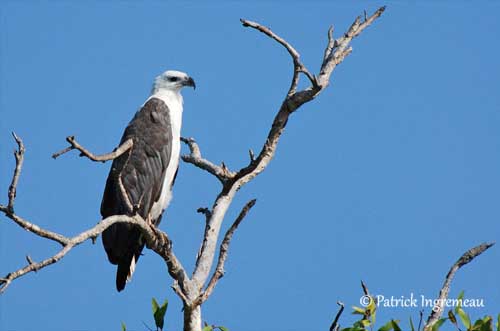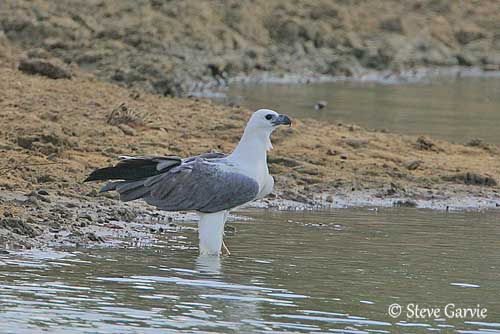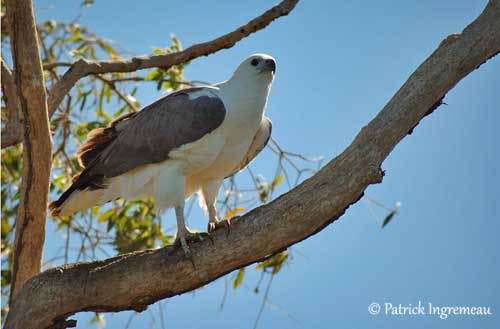
Fr: Pygargue blagre
All : Weißbauch-Seeadler
Esp: Pigargo Oriental
Ital : Aquila di mare ventrebianco
Nd: Witbuikzeearend
Sd: Vitbukad havsörn
Photographers:
Steve Garvie
RAINBIRDER Photo galleries
Patrick Ingremeau
TAMANDUA
Ingo Waschkies
Bird Photography
Text by Nicole Bouglouan
Sources:
HANDBOOK OF THE BIRDS OF THE WORLD Vol 2 by Josep del Hoyo-Andrew Elliot-Jordi Sargatal - Lynx Edicions - ISBN: 8487334156
A photographic guide to Birds of Vietnam, Cambodia and Laos by Peter Davidson. New Holland Publishers. ISBN: 9781847731418
A Field Guide to the Birds of South-East Asia by Craig Robson. New Holland Publishers. ISBN: 9781780090498
BirdLife International (BirdLife International)
Birds in backyards (Birds Australia and Australian Museum)
Sungei Buloh Wetlands Reserve (Michael Mastaller)
Wikipedia, the free encyclopaedia
White-bellied Sea-Eagle
Haliaeetus leucogaster
Accipitriforme Order – Accipitridae Family
BIOMETRICS:
Length: 78-85 cm
Wingspan: 180-218 cm
Weight: M: 2120-2900 g – F: 2900-3400 g
DESCRIPTION:
This large eagle is resident in its range and forms permanent pair. Both mates are living in their territory all year round. The hunting behaviour typical of these raptors is very spectacular.
The White-bellied Sea-Eagle adult has grey upperparts and wings. Head, neck and underparts are white. The short tail is white with blackish base. The flight feathers are black.
On the underwing, the black flight feathers contrast strongly with the white coverts.
The hooked bill is pale blue-grey with dark tip and grey cere. The eyes are dark brown. Legs and feet are grey to pale yellow, with long, curved black talons.
Both sexes are similar in plumage, but female is larger than male.

The juvenile has dark brown upperparts and wings, with white-edged feathers on back and wing-coverts. The tail is white with brown subterminal band.
Head and underparts are brownish with some white markings. On the underwing, coverts are buffish, secondaries are dark and primaries show large whitish patch. Flight feathers are blackish. The eyes are paler, mostly greyish.
The subadult resembles adult with duller breast. Underwing-coverts are whitish and contrast with blackish primary tips. The eyes are brown.
It acquires the full adult plumage by its 5th year.
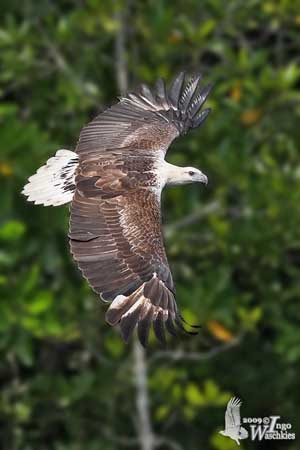
VOICE: SOUNDS BY XENO-CANTO
The White-bellied Sea-Eagle gives loud goose-like honking calls “hank hank hank…” typically heard during the breeding season.
We can also hear shorter “ken-ken-ken-ken…” and “ka ka kaa…”
HABITAT:
The White-bellied Sea-Eagle is found on islands, inshore seas, rocky coasts, large inland waterbodies, estuaries and wetlands, often over nearby wooded or open habitats.
This species can be seen from sea-level up to 1400/1700 metres of elevation. However, this eagle breeds in lowlands such as forest, woodland or rocky area.
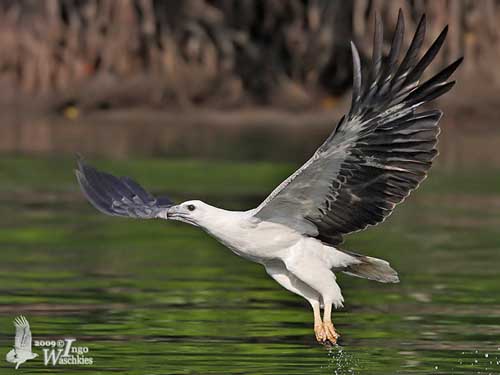
RANGE:
The White-bellied Sea-Eagle is found in India, Bangladesh, Sri Lanka, Andaman and Nicobar Islands, S, SE China, Sundas, Philippines, Wallacea, New Guinea, Bismarck Archipelago and Australia.
BEHAVIOUR:
The White-bellied Sea-Eagle feeds primarily on fish between 200 and 1000 gr, sometimes larger. The fish is caught with the long talons. The eagle hunts often from perch and swoops down to the prey which is usually near the water surface. Then, the fish is brought to a perch to be eaten. The larger preys are drawn to the shore.
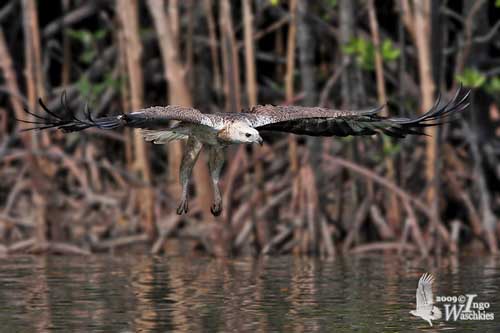
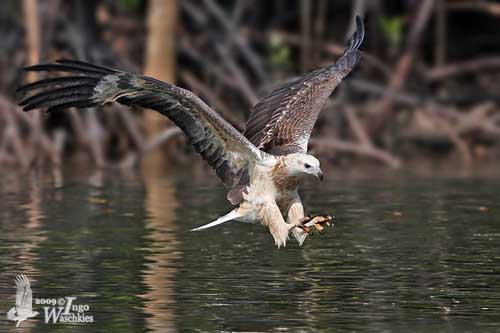
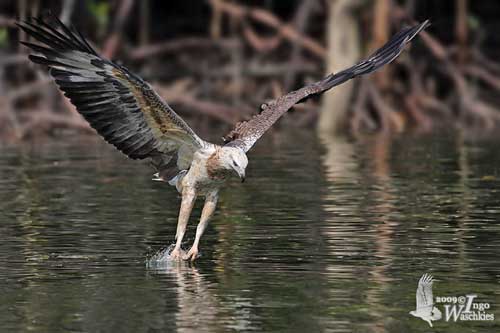
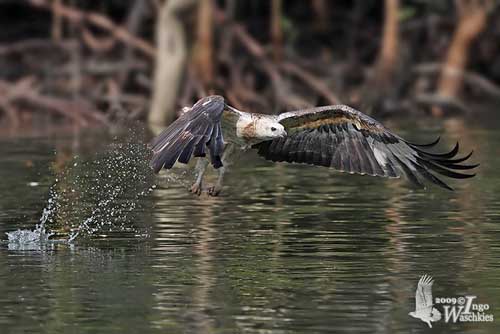
It takes various aquatic preys such as spiny and poisonous fish, turtles and sea snakes. Other food items include mammals (rabbits and fruit-bats of genus Pteropus), birds such as waterfowl, and seabirds as large as gulls, cormorants or gannets.
It also hunts by soaring high in the air, attacking by a shallow dive or glide. The prey is caught from ground or water.
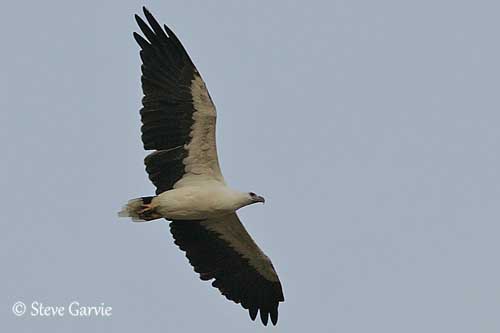
It harasses the aquatic birds, and robs their food, attacking them with outstretched talons from above, or even flying upside down underneath its victim to steal its prey. Bats are taken from their roosts in trees, and it robs other predatory species including foraging dolphins! It benefits from carrion and offal from water surface.
This species is very opportunistic, taking advantage of numerous occasions to feed to the detriment of other birds.
It forages alone, in pairs or in family groups, but more often in pairs.
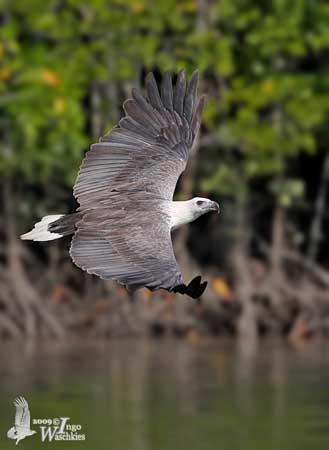
The White-bellied Sea-Eagle forms permanent pair, and remains in its territory all year round. During the breeding season, they perform acrobatic aerial displays typical of eagles.
The flight display includes somersaults, side-slipping and stoops. Both mates fly together and lock their talons. Then, they tumble together through the air while giving their honking calls.
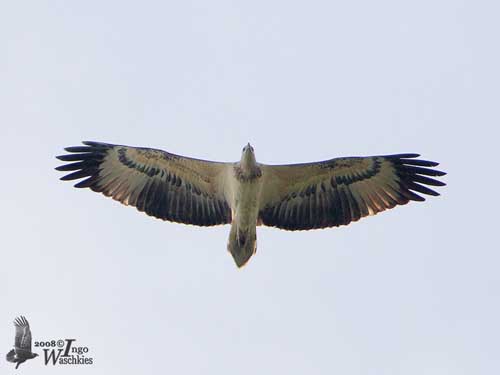
The White-bellied Sea-Eagle adult is sedentary in its range, but juvenile and immature birds disperse and wander over large area. They may follow the large rivers for considerable distance inland.
FLIGHT:
The White-bellied Sea-Eagle performs heavy flapping flight during which the wings are held in typical V-shape. But it tends to soar a lot with slow wingbeats.
When foraging, it circles on thermal currents for rising and then, it glides low over water.
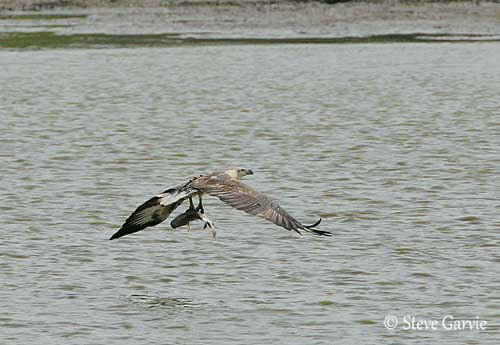
REPRODUCTION:
The breeding season varies according to the range, between May and September in Australia, and in dry season in Asia and tropics. The White-bellied Sea-Eagle is solitary nester.
The nest is very large and bulky, a wide, deep stick platform placed in tall tree, man-made pylons, rock ledge in cliff or offshore islands, usually between 10 and 50 metres above the ground.
The cup is lined with green vegetation. The same nest is often reused year after year, and grows more and more until becoming a huge pile of sticks.
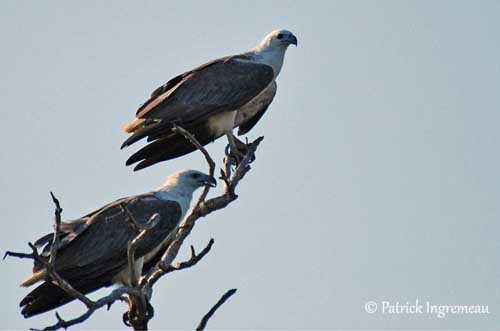
The female lays two bluish-white eggs. She incubates during 40 days. She is fed by the male during this period, and it defends the nest too. At hatching, the chicks are covered in white down. They are fed by both parents. They fledge 65-70 days after hatching. They can breed at 7 years old.
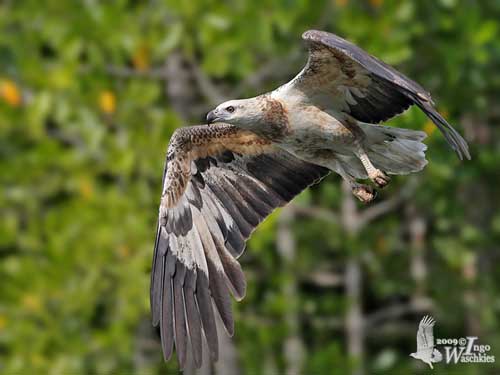
DIET:
The White-bellied Sea-Eagle feeds primarily on fish, but it also takes mammals, birds, turtles, reptiles, carrion and offal from water surface.
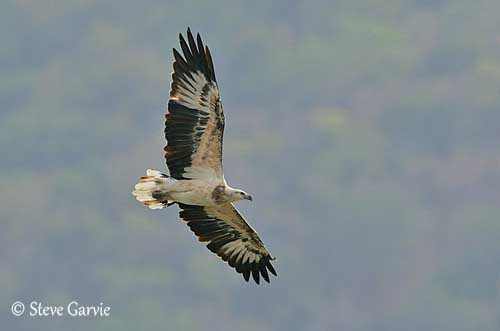
PROTECTION / THREATS / STATUS:
The White-bellied Sea-Eagle is usually fairly common, but local declines are reported, due to destruction of the habitat and disturbance at nest-sites.
Introduced preys and rubbish dumps in some areas help this species to maintain its populations.
Currently, the White-bellied Sea-Eagle is not threatened and evaluated as Least Concern by BirdLife International.
